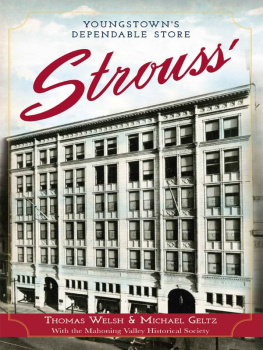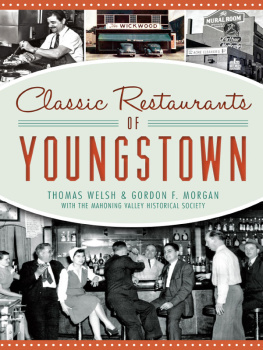Published by The History Press
Charleston, SC 29403
www.historypress.net
Copyright 2009 by Mark C. Peyko
All rights reserved
First published 2009
Second printing 2010
Third printing 2011
Fourth printing 2012
e-book edition 2013
Manufactured in the United States
ISBN 978.1.62584.254.1
Library of Congress Cataloging-in-Publication Data
Remembering Youngstown : tales from the Mahoning Valley / edited by Mark C. Peyko.
p. cm.
print edition ISBN 978-1-59629-708-1
1. Youngstown (Ohio)--History--Anecdotes. 2. Youngstown (Ohio)--Social life and customs--Anecdotes. 3. Youngstown (Ohio)--Biography--Anecdotes. I. Peyko, Mark C.
F499.Y8R28 2009
977.139--dc22
2009012221
Notice: The information in this book is true and complete to the best of our knowledge. It is offered without guarantee on the part of the author or The History Press. The author and The History Press disclaim all liability in connection with the use of this book.
All rights reserved. No part of this book may be reproduced or transmitted in any form whatsoever without prior written permission from the publisher except in the case of brief quotations embodied in critical articles and reviews.
INTRODUCTION
Whenever history and journalism are able to cross paths, its a good thing. History gives perspective. It allows readers to better understand present-day situations and dilemmas. Even in breaking news, background history can give readers a critical depth of understanding.
However, history can mislead. It makes fools of us through its silence, by what has been willfully omitted in the dusty volumes of a research library. Because historical record is susceptible to misinterpretation and abuse, it is important to seek the truth. History is not always beautiful or comforting, but thats often what makes it worth exploring.
Despite these pitfalls, history remains one of the best ways to examine and interpret culture. This work features some of the best history articles that have appeared in the Metro Monthly since its inception. As publisher, I have chosen articles that reflect a broad range of subject matter. Although this book does not cover the total history of the Mahoning Valley, it does include some of the more interesting aspects of Youngstown history. In addition, I think it also accurately reflects the consistently broad and varied interests of the Metro Monthly.
Youngstown, Ohio, is rich in history. Due to its ethnicity and diverse culture, the town is a much bigger city than its present-day population numbers would suggest. To the casual observer, Youngstown may appear to be a series of interconnected urban legends and exaggerations, but if you work in the media long enough youll find out that many of these stories are true. What happens in Vegas may stay in Vegas, but what happens in Youngstown is told for generations.
Youngstown is filled with great storytellers. I hope this volume lives up to that well-respected tradition.
PART I
SETTLEMENT AND GROWTH IN THE MAHONING VALLEY
CHURCH CONGREGATIONS PROVIDE GLIMPSES INTO ETHNIC LEGACIES OF YOUNGSTOWN NEIGHBORHOODS
Rebecca Rogers
Almost all early settlers of the Mahoning Valley came west from Pennsylvania, New York and New England.
Early settlers worked in agriculture, but by the mid- to late nineteenth century, a growing industrial economy soon attracted emigrants from northern, central and eastern Europe.
Recent research has determined that many of the settlers of the pioneer period and farm-dependent economy of northeastern Ohio did not have enough money to buy land or enough training to be journeymen or masters of a trade.
Like subsequent urban European and African American immigrants, early settlers often left little personal history or record of their lives here. Instead, the strongest legacy of each immigrant group had been the church congregations that were often located at the center of the community or ethnic neighborhood.
As the village economy of Youngstown began to grow rapidly following a national depression in the late 1830s, the climate for the assimilation of an immigrant population improved. New settlers came to the Mahoning Valley when the crosscut Pennsylvania Canal, which connected New Castle, Pennsylvania, to Akron, Ohio, was started. The canal provided opportunity for laborers, especially stonemasons, and workers who drove horse teams [draymen].
The forecast of prosperity encouraged many merchants, financiers and goods manufacturers, who saw the opportunity of a reliable transportation system, making Youngstown a boomtown.
Shortly after the opening of the canal in 1840, coal was discovered near the Brier Hill farm of David Tod. The nascent industry attracted coal miners to the Mahoning Valley and Youngstown. Canal construction and mining attracted rural and European immigrants, with the largest number of foreign-born workers being Welsh and Irish. Both ethnic groups settled near Brier Hill.
The presence of these immigrant groups is evident in the churches that they established, many dating from the 1840s. St. Columbas Catholic Church was established around 1840. The parish grew from earlier missions that met east of Brier Hill and on Youngstowns East Side. In the village of Brier Hill, a Welsh Congregational Church was formed around 1840 and a Welsh Presbyterian Church was established soon after.
East of Brier Hill and south of the main road to Warren, Ohio, a worker neighborhood known as the Caldwell District grew in the floodplain of the Mahoning River. This area, like Brier Hill, had a mix of ever-changing immigrant residents. The Caldwell District provided labor for the Eagle, Cartwright and McCurdy furnaces.
In Youngstown, the south side of the Mahoning River attracted immigrants somewhat laterin the 1850s and 1860sfollowing the construction of the Phoenix and Falcon blast furnaces on the north bank. Irish immigrants settled along Poland Avenue and Flint Hill Street [South Avenue] across the Presque Isle [South Avenue] Bridge. The area quickly became so predominantly Irish American that it was locally known as Kilkenny. St. Columbas founded a mission and a parochial school there on Franklin Avenue.
Farther westfrom the bluff on the south bank of the Mahoning River to Mill Creekalong Mahoning Avenue, German immigrants established a neighborhood. They organized Lutheran meetings above the south riverbank, near present-day Warren Avenue, in the mid-1850s. In 1859, German Lutherans organized Martin Luther Church and built a house of worship on East Wood and Champion Streets in 1862. The Mannerchor [a German mens choir] was established in the early 1860s and hosted picnics and songfests near the bluff. Germans settling in Brier Hill established St. Josephs Catholic Church on Rayen Avenue in 1870, and St. Pauls Evangelical Lutheran Church was founded in 1881. Its interesting to note that Brier Hill and the neighborhood west of lower Belmont Avenue had many streets with German names, some of which were renamed during World War I.










